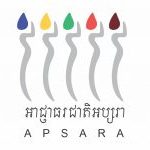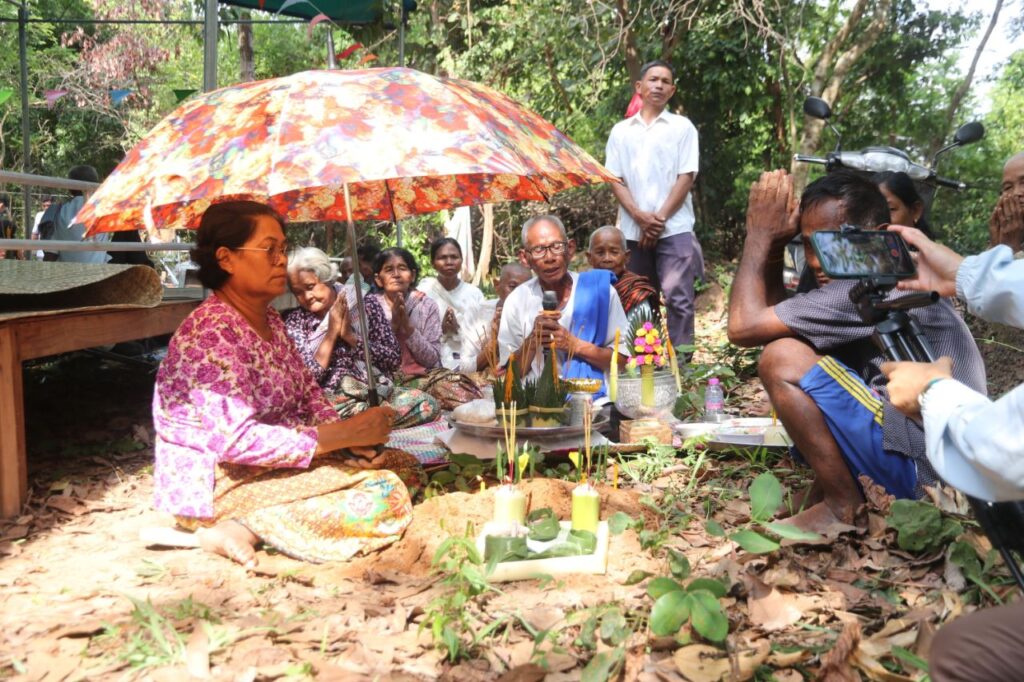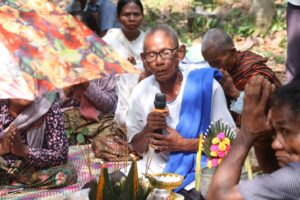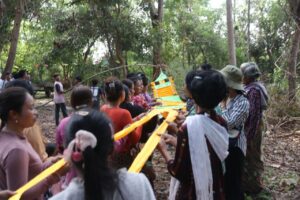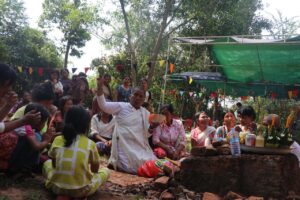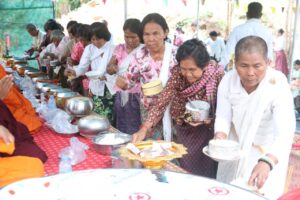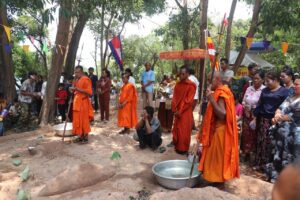អ្នកស្រុកអង្គរនៅតែពឹងផ្អែកលើទឹកភ្លៀង ដើម្បីធ្វើស្រែចម្ការ។ នៅរដូវវស្សា ពេលខ្លះភ្លៀងធ្លាក់ពុំត្រូវតាមពេលវេលា ខ្លះរាំងភ្លៀង ទឹកមិនគ្រប់គ្រាន់ ពេលខ្លះភ្លៀងធ្លាក់ច្រើនពេក ទាំងនេះហើយ ជាកង្វល់យ៉ាងធំរបស់អ្នកស្រុក។ ពិធីសុំទឹកភ្លៀងនេះ ធ្វើខុសគ្នាពីភូមិទៅភូមិមួយ ហើយជាពិធីទាក់ទងនឹងជំនឿជីវចលតែប៉ុណ្ណោះ តែយ៉ាងណាក៏មានកិច្ចក្នុងពុទ្ធសាសនាខ្លះដែរ។
ជាក់ស្តែងប្រជាពលរដ្ឋរស់នៅភូមិស្រែចង្ហូត បានរៀបចំធ្វើពិធីសុំទឹកភ្លៀង និងបុណ្យឆ្លងចេត្ររួមគ្នានៅប្រាសាទលាក់នាង នាថ្ងៃទី២២-២៣ ខែមេសា ឆ្នាំ២០២៥។ បន្ទាប់ពីកិច្ចពិធីតាមសាសនា និងបញ្ជូលរូបស្នងបានរាំលេងសប្បាយហើយ នៅខាងមុខប្រាសាទលាក់នាង ទៀតសោត អ្នកភូមិបានសូនដីខ្សាច់រាងបួនជ្រុងជារូបនាគព័ន្ធ តំណាងស្រះទឹក ក្នុងស្រះមានសត្វដូចជា ក្តាម ត្រី កង្កែប អណ្តើក ក្រពើ កំពឹស ខ្យង អន្ទង់ ដែលត្រូវមានកិច្ចពិធីនិមន្តព្រះសង្ឃគង់ឈរជុំវិញស្រះ សូត្រធម៌មហាមេឃ ដើម្បីសុំទឹកភ្លៀង។ ពេលសូត្រចប់អ្នកភូមិស្រង់ទឹកដល់ព្រះសង្ឃ និងចាស់ទុំ រួមទាំងលេជះទឹកឧបកិច្ចថា មានភ្លៀងធ្លាក់មកគ្រប់គ្រាន់ ទិន្នផលស្រូវដំណាំទទួលបានគាប់ប្រសើរដូចការប៉ងប្រាថ្នាពិតប្រាកដមែនរាំរែកសប្បាយ៕
អត្ថបទ៖ ឆាយ ផាន់នី
រូបភាព៖ លោក ភោគ ជា,លោក យី សុថា
The villagers of Sre Changhot recently held a vibrant rain-praying ceremony at Leak Neang Temple, coinciding with the Chlong Chet festival on April 22-23, 2025. This annual event is deeply rooted in the community’s agricultural lifestyle, as the residents of Angkor heavily depend on rain for their crops.
During the rainy season, the villagers face challenges due to unpredictable rainfall, which can lead to either drought or flooding—issues that significantly impact their livelihoods. The rain-praying ceremony, which varies from one village to another, combines elements of local beliefs and Buddhist practices.
At the ceremony, the community came together to create a square sand formation shaped like a Naga, symbolizing a pond filled with various animals such as crabs, fish, frogs, turtles, crocodiles, snails, and eels. Monks surrounded this symbolic pond and chanted the Dhamma of the heavens in hopes of invoking rain.
Following the chanting, a joyful water-sprinkling ceremony took place where villagers poured water over the monks and elders. This act was a gesture of gratitude and a prayer for sufficient rain and bountiful rice crops. The festivities culminated in dancing and celebration, reflecting the villagers’ hopes for a prosperous agricultural season ahead.
Article by Chhay Phanny
Photos by Phouk Chea/Yi Sotha
Translation by Net Phirun
